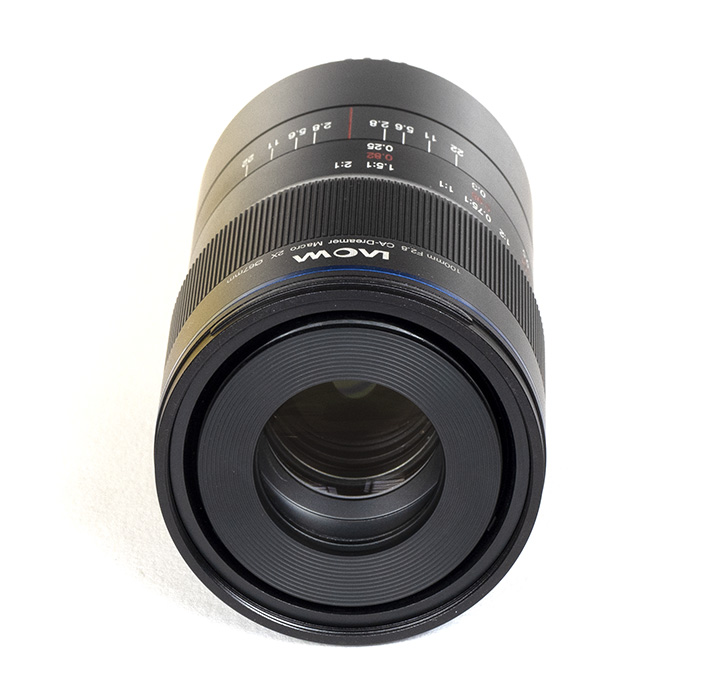|
Laowa 100mm f/2.8 2x Macro APO - Review / Test Report |
|
Lens Reviews -
Canon EOS (Full Format)
|
|
Page 1 of 3
 Review by Klaus Schroiff, published May 2019
Review by Klaus Schroiff, published May 2019
Introduction
Over recent years, we've seen a flood of fully manual focus lenses - some more interesting than others.
However, at the end of the day, these are niche products that probably find more friends in the movie segment rather than among photographers.
If a manufacturer wants to go mainstream, they have to offer electronic coupling with the camera. Of course, that's easily said but
reverse-engineering camera protocols is a tough job. It has been a tough job for Laowa as well but they have just released their first lens featuring
a camera-controlled aperture and support for EXIF data - albeit only in Canon EOS mount (mechanical aperture coupling is available in Nikon mount).
Meet the Laowa 100mm f/2.8 2x Macro APO, Laowa's 2nd macro lens. While the lens does still come without AF, the in-focus confirmation in the camera viewfinder is available. Keep in mind, however,
that isn't really an overly accurate way of focusing on a telelens. Instead, you should use focus magnification which is a good idea anyway at
very close focus distances and the lens is optimized for that purpose. Namely, it can magnify objects up to a factor of 2x - thus the object size can
be up to twice as large on the sensor as in real life. This sets it apart from conventional macro lenses which are usually constraint to a max.
object magnification of 1:1 or even 1:2. It is priced at 449USD. As such it is somewhat more affordable than your typical third-party macro lens in this segment.
 The lens construction is a slight departure from what we've seen from Laowa so far - the "missing" aperture ring is, of course, something new but the lens
is marginally longer than usual albeit it is fairly "slim". So far Laowa had an emphasize on creating smaller than average lenses.
Quality-wise it feels pretty nice with all visible parts made of metal. The focus ring operates smoothly and is very precise and well dampened.
The lens does - seemingly - show a depth-of-field scale but this has more decorative values rather than being useful (it is way too coarse).
The lens construction is a slight departure from what we've seen from Laowa so far - the "missing" aperture ring is, of course, something new but the lens
is marginally longer than usual albeit it is fairly "slim". So far Laowa had an emphasize on creating smaller than average lenses.
Quality-wise it feels pretty nice with all visible parts made of metal. The focus ring operates smoothly and is very precise and well dampened.
The lens does - seemingly - show a depth-of-field scale but this has more decorative values rather than being useful (it is way too coarse).
 As you may have already spotted in the product image above, there's an inner lens tube that moves to the front the closer you focus (a so-called linear extension system)
whereas the size of the lens remains constant. Or in other words - the optical system is deeply recessed into the lens body at long focus distances thus a lens hood is not necessary nor supplied.
You may debate whether this approach is good or bad. A constant size is - obviously - something predictable and small critters don't get too nervous.
An alternative approach would have been to have a much shorter lens that extends.
Move your mouse cursor over the image to see the focus group in action.
As you may have already spotted in the product image above, there's an inner lens tube that moves to the front the closer you focus (a so-called linear extension system)
whereas the size of the lens remains constant. Or in other words - the optical system is deeply recessed into the lens body at long focus distances thus a lens hood is not necessary nor supplied.
You may debate whether this approach is good or bad. A constant size is - obviously - something predictable and small critters don't get too nervous.
An alternative approach would have been to have a much shorter lens that extends.
Move your mouse cursor over the image to see the focus group in action.

| Specifications |
|---|
| Optical construction | 12 elements in 10 groups including 2xED elements |
| Number of aperture blades | 9 for Canon, 13 for Sony FE, 7 for Nikon |
| min. focus distance | 0.247m (max. magnification ratio 2:1) |
| Dimensions | 72x125mm |
| Weight | 638g |
| Filter size | φ67mm |
| Hood | - |
| Other features | - |
|